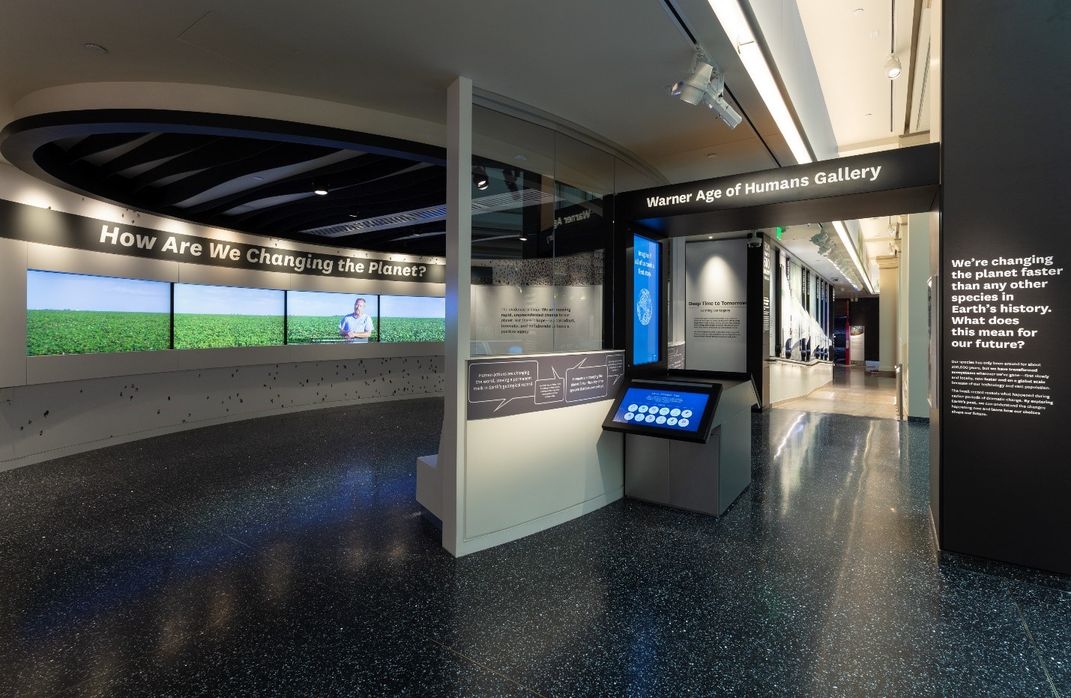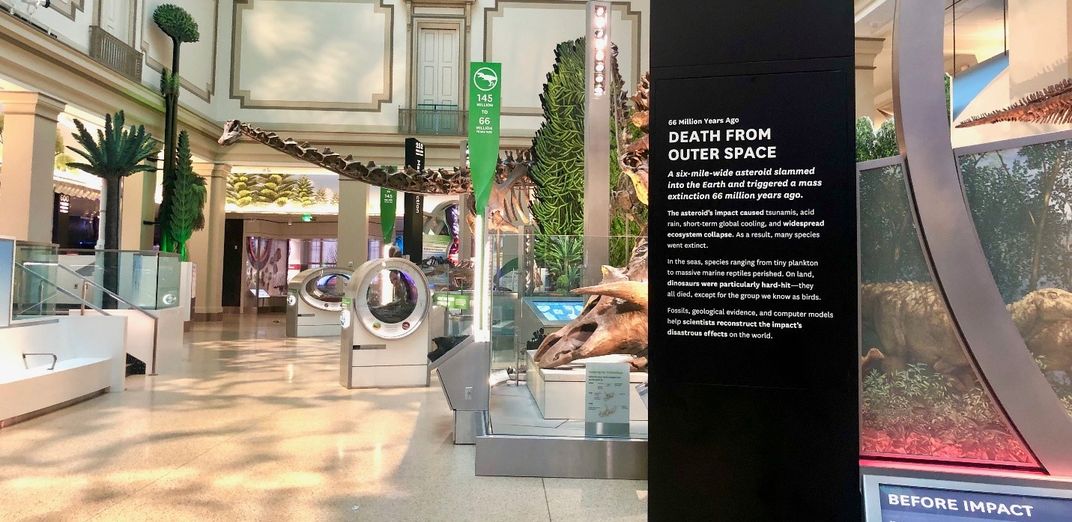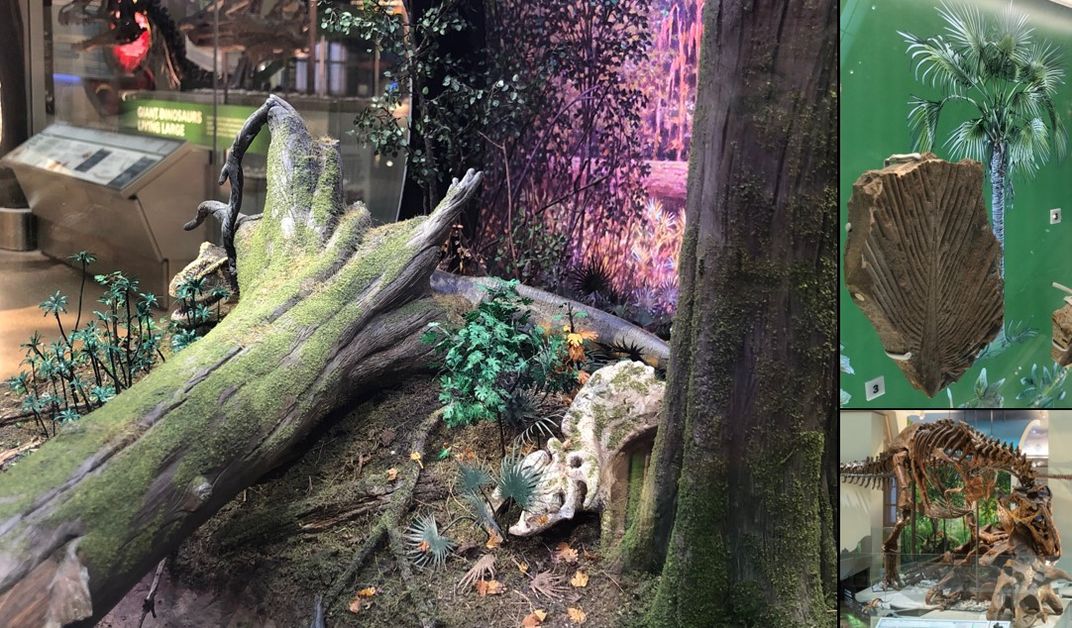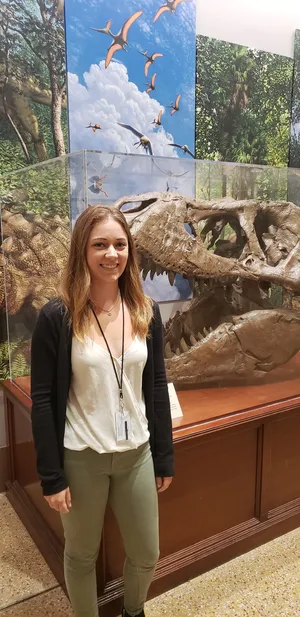NATIONAL MUSEUM OF NATURAL HISTORY
Five Things You Shouldn’t Miss in the New Fossil Hall
Here’s what the experts behind “Deep Time” don’t want you to miss.
/https://tf-cmsv2-smithsonianmag-media.s3.amazonaws.com/blogging/featured/NMNH-2019-00516.jpg)
Countless stories await discovery in the National Museum of Natural History’s new flagship exhibit – the “David H. Koch Hall of Fossils – Deep Time”. Often the big ones capture the most attention, such as a Tyrannosaurus rex chowing down on Hatcher the Triceratops.
“But there are hundreds of things that any one person is not going to notice,” says Matthew Carrano, the Smithsonian’s Curator of Dinosauria.
And that even includes staff. Carrano, for instance, never realized that a rhino ancestor in “Deep Time” is lying in the same position as the Hall of Mammals’ taxidermied rhino across the rotunda. At least until someone asked him if the resemblance was intentional. It wasn’t, but Carrano still considers the fact that someone noticed a success.

“It must have gotten the rhino-ness across,” Carrano says.
Though people might miss some details displayed within the hall, here are the ones visitors shouldn’t overlook.
When Earth had a fever
To understand what ‘Deep Time’ is saying about today guests should stop at a spot on the main alley, says Siobhan Starrs, Exhibition Project Manager for “Deep Time”.
The display is across from the mastodon and draws a parallel to today’s climate change. It outlines an event that was ripped from 56 million years ago, called the Paleocene-Eocene Thermal Maximum. During that period, carbon dioxide and temperature spiked, driving many species to extinction.
Visitors can then make their way through the Warner Age of Humans Gallery nearby where they’ll learn about humanity’s impacts on the planet.
“We are impacting the world faster and on a bigger scale than ever,” Starrs says. “Just as we’ve changed it to drive it to where we are today, we can change the course moving forward – we just have to decide what we want to do.”

Signposts guide the way
Wandering around the exhibit is like riding the subway, says Amy Bolton, “Deep Time” Education and Outreach Manager. When riders step off, they want to know where they are and what’s around them. Just like the subway, “Deep Time” needed a map to guide visitors among displays spanning millions of years.

The team that designed the exhibit made it simple for visitors to jump around the 31,000 square-foot space. They incorporated placards at the beginning of each section – some of which tower above the crowd like flags – to help guests find where they are in time.
The goal of the markers is to help people draw connections between events to understand how Earth works and how it has changed. They can see broad patterns and gain a new perspective on climate change or deep time.
“There’s a lot of stuff to keep track of in the hall,” Bolton says. But she hopes that visitors will take a minute to familiarize themselves with where they are in Earth’s timeline before diving into a display.
Earth’s dynamic oceans
Along the edges of “Deep Time” is a tale that plunges beneath the surface. While the exhibit’s main walkway focuses on life on land, its southern wall reveals what happened in the oceans. Anna “Kay” Behrensmeyer, one of the Smithsonian’s Curators of Vertebrate Paleontology, hopes museum guests venture off the terrestrial path and submerge themselves in prehistoric waters.
“There are some wonderful fossils back there,” Behrensmeyer says.

Life got its start in the ocean over 3.7 billion years ago, so the exhibit’s marine story goes back to the beginning. As visitors travel through the oceanic past they can see what an ancient fish, Xiphactinus audax, ate for dinner 90 – 89 million years ago or a massive plesiosaur from the Jurassic that takes up almost an entire display.
This part of “Deep Time” helps guests understand how mass extinctions wiped out numerous marine species and how life repeatedly adapted to oceanic environments. Its narrative is a treat for those curious about the transformation of Earth’s oceans, Behrensmeyer says.
How humans warm the planet
Tucked away in a part of the fossil hall close to the African Voices exhibit entrance is Fossil Basecamp. The area is a place to connect all the ideas that the hall introduces, from how scientists figure out a fossil’s age to how humans drive climate change. Here, visitors can watch a video that Scott Wing, a Smithsonian Curator of Fossil Plants, doesn’t want people to miss.
“It’s 324 words in 3 minutes about the most important thing that there is, Wing says.
The video is part of a display describing how Earth works and explains how carbon – which is essential to life – cycles through the environment. It begins with a balanced system: plants and animals pull carbon from the atmosphere and release it when they die; coal and limestone stockpile it in the Earth. But when humans start burning fossil fuels, the system goes out of whack.
Visitors could watch it three or four times and still pick up important bits of information, Wing adds.
Bringing ancient fossils to life
Diorama-like displays are a hallmark of museum exhibits. These exquisite renderings show visitors a glimpse of what a scene from the past may have looked like. The “Deep Time” miniature dioramas appear to be simple depictions of events from ancient history. But each detail was meticulously embedded inside the striking glass cases that dot the walkways.
“Most of the things in the dioramas have their fossils in the exhibit nearby,” says dinosaur expert Carrano.

The animal species within each capsule are a clear parallel. For instance, in a scene from 67 – 66 million years ago in the Hell Creek Formation in Montana, a T. rex hides behind a tree just beyond a Triceratops skull. Meanwhile, next door in a bigger display, its larger counterpart has its teeth on Hatcher.
But the tree leaves were also laser cut to resemble fossils from that period. Visitors can find a palm leaf fossil that was the model for leaves in the Montana diorama displayed behind the life-size T. rex.
“For any one person, they’ll miss a lot. But hopefully, on average, everything gets noticed by somebody,” Carrano says.
Related Stories:
How Exhibit Writers Tackled Earth’s 4.6 Billion Year History in ‘Deep Time’
The Experts Behind the New Fossil Hall Wrap Their Minds Around ‘Deep Time’
Try These Hands-on Activities in the Smithsonian’s New Fossil Hall
Old Fossils, New Meanings: Smithsonian Exhibit Explores the History of Life and What it Means for Our Future



